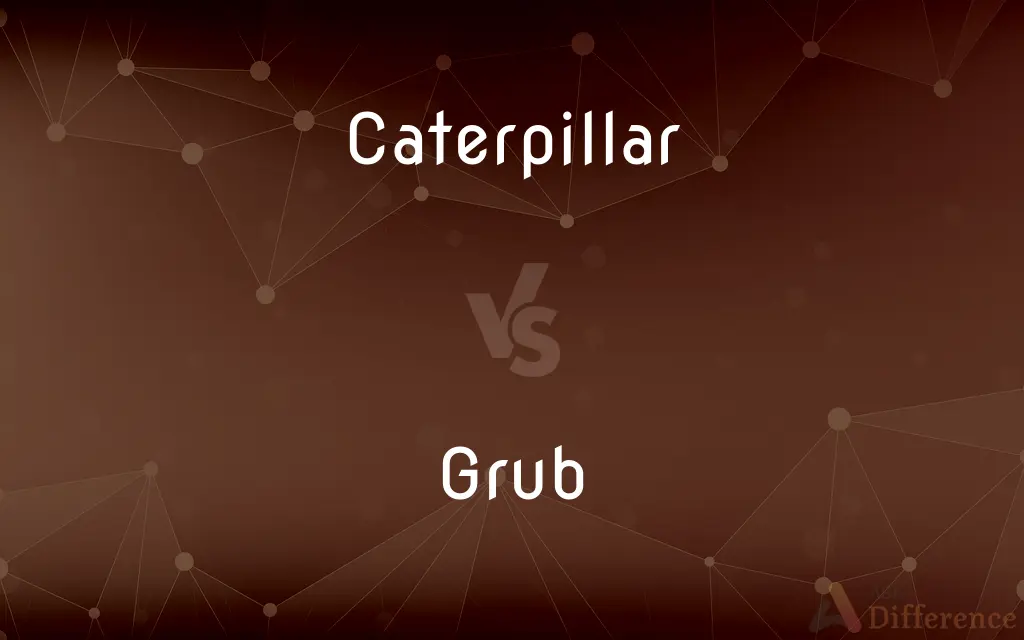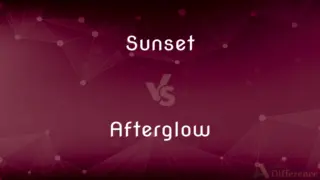Caterpillar vs. Grub — What's the Difference?
By Tayyaba Rehman & Fiza Rafique — Updated on May 12, 2024
Caterpillars are larval stages of butterflies and moths, known for their segmented bodies and multiple legs; grubs, on the other hand, are beetle larvae, generally softer with a C-shaped body and fewer visible legs.

Difference Between Caterpillar and Grub
Table of Contents
ADVERTISEMENT
Key Differences
Caterpillars, the larval stage of butterflies and moths, exhibit a distinct appearance with elongated, segmented bodies and many pairs of legs. While grubs, which are the larvae of beetles, typically have a softer, C-shaped body and lack the prominent segmentation and numerous legs seen in caterpillars.
Caterpillars are often brightly colored or have specific patterns that serve as warnings to predators about their potential toxicity. Whereas grubs are usually pale and uniform in color, blending into their subterranean or wood-based environments where they are less visible to predators.
The diet of caterpillars generally consists of leaves, and they are known to feed on a wide variety of plants, often visible on the foliage. On the other hand, grubs are commonly found underground or within wood, feeding on roots, decomposing organic materials, or the wood itself.
In terms of behavior, caterpillars can be found actively feeding on plants, and many species are solitary. Grubs, however, are usually hidden from view, living a more secluded life beneath the soil or inside plant matter, and their presence is often indicated only by damage to plants or trees.
Caterpillars undergo several molts as they grow, each time shedding their skin to allow for further growth. Grubs also molt, but their life underground shields these processes from the casual observer, making their developmental stages less apparent than those of caterpillars.
ADVERTISEMENT
Comparison Chart
Stage of Life
Larval stage of butterflies and moths
Larval stage of beetles
Body Shape
Segmented, elongated
Soft, C-shaped
Legs
Many pairs, visible
Few, less visible
Color
Often bright, patterned
Usually pale, uniform
Habitat
On plants, visible
Underground or inside wood, hidden
Compare with Definitions
Caterpillar
Known for their distinctive patterns and colors, which can indicate toxicity.
The brightly colored caterpillar deters predators with its vivid patterns.
Grub
Typically has a soft, white body with a distinct, C-shaped curve.
The grub curled up into a C-shape when exposed during gardening.
Caterpillar
Found primarily on the foliage of plants.
Caterpillars are often seen eating away at the leaves of your garden plants.
Grub
Fewer legs located near the head, not easily seen.
Despite having fewer legs, the grub moves effectively through the soil.
Caterpillar
Undergoes multiple molts before pupating.
The caterpillar sheds its skin one last time before it becomes a pupa.
Grub
Presence indicated by plant or lawn damage.
Patches of dead grass often indicate a grub infestation below.
Caterpillar
A larval stage of butterflies and moths that typically feeds on leaves.
A monarch caterpillar munches on milkweed as it prepares for metamorphosis.
Grub
To dig up by or as if by the roots
Grubbed carrots with a stick.
Caterpillar
Possesses multiple sets of true legs and additional prolegs.
The caterpillar uses its numerous legs to navigate quickly across leaves.
Grub
To clear of roots and stumps by digging
Grubbed a small plot.
Caterpillar
Caterpillars ( CAT-ər-pil-ər) are the larval stage of members of the order Lepidoptera (the insect order comprising butterflies and moths). As with most common names, the application of the word is arbitrary, since the larvae of sawflies are commonly called caterpillars as well.
Grub
(Slang) To obtain by importunity
Grub a cigarette.
Caterpillar
The wormlike larva of a butterfly or moth.
Grub
To dig in the earth
Grub for potatoes.
Caterpillar
Any of various insect larvae similar to those of the butterfly or moth.
Grub
To search laboriously by or as if by digging; rummage.
Caterpillar
The larva of a butterfly or moth; leafworm
The bird just ate that green caterpillar.
Grub
To toil arduously; drudge
Grub for a living.
Caterpillar
A vehicle with a caterpillar track; a crawler
Grub
The thick wormlike larva of certain beetles and other insects.
Caterpillar
(maths) A set of subtrees of a tree
Grub
A drudge.
Caterpillar
The larval state of a butterfly or any lepidopterous insect; sometimes, but less commonly, the larval state of other insects, as the sawflies, which are also called false caterpillars. The true caterpillars have three pairs of true legs, and several pairs of abdominal fleshy legs (prolegs) armed with hooks. Some are hairy, others naked. They usually feed on leaves, fruit, and succulent vegetables, being often very destructive, Many of them are popularly called worms, as the cutworm, cankerworm, army worm, cotton worm, silkworm.
Grub
(Slang) Food.
Caterpillar
A plant of the genus Scorpiurus, with pods resembling caterpillars.
Grub
(countable) An insect at an immature stage of its life cycle.
Caterpillar
A wormlike and often brightly colored and hairy or spiny larva of a butterfly or moth
Grub
Food.
Pub grub
Caterpillar
A large vehicle that is driven by caterpillar tracks; frequently used for moving earth in construction and farm work
Grub
A dirty person.
Grub
A despicable person; a lowlife.
Grub
(obsolete) A short, thick man; a dwarf.
Grub
To scavenge or in some way scrounge, typically for food.
Grub
(ambitransitive) To dig; to dig up by the roots; to root out by digging; often followed by up.
To grub up trees, rushes, or sedge
Grub
To supply with food.
Grub
To eat.
Grub
To dig in or under the ground, generally for an object that is difficult to reach or extricate; to be occupied in digging.
Grub
To drudge; to do menial work.
Grub
To dig; to dig up by the roots; to root out by digging; - followed by up; as, to grub up trees, rushes, or sedge.
They do not attempt to grub up the root of sin.
Grub
To supply with food.
Grub
The larva of an insect, especially of a beetle; - called also grubworm. See Illust. of Goldsmith beetle, under Goldsmith.
Yet your butterfly was a grub.
Grub
A short, thick man; a dwarf.
Grub
Victuals; food.
I 'd sooner ballads write, and grubstreet lays.
Grub
Informal terms for a meal
Grub
A soft thick wormlike larva of certain beetles and other insects
Grub
Ask for and get free; be a parasite
Grub
Search about busily
Grub
A beetle larva, often found underground or in wood, feeding on organic material.
Grubs can cause significant damage to lawns as they feed on grass roots.
Grub
Life cycle includes stages of egg, larva, pupa, and adult.
The grub will eventually pupate and emerge as a fully formed beetle.
Common Curiosities
How does the life cycle of a caterpillar differ from that of a grub?
Both undergo transformations through larval, pupal, and adult stages, but caterpillars are more likely to be observed during their growth due to their above-ground activities.
Are caterpillars or grubs harmful to plants?
Both can be harmful; caterpillars eat leaves, potentially defoliating plants, while grubs damage roots and wood, impacting plant health from below.
What is the primary difference in habitat between a caterpillar and a grub?
Caterpillars are commonly found on plants, visible and exposed, while grubs live underground or inside wood, hidden from view.
How do caterpillars and grubs affect the ecosystem?
They play crucial roles in the food chain and contribute to the ecological dynamics of their environments by acting as prey and affecting plant health.
What do caterpillars eat compared to grubs?
Caterpillars primarily eat leaves, while grubs feed on roots, decaying wood, or other underground organic materials.
How can one manage the presence of caterpillars without harming them?
Use non-toxic methods like handpicking or applying neem oil to control their numbers while preserving beneficial insects.
What is the significance of the coloration in caterpillars?
Bright colors or patterns often serve as warnings to predators about the caterpillar's potential toxicity or bad taste.
How can you tell a caterpillar from a grub by looking at them?
Caterpillars have segmented bodies with multiple legs and are often colorful, whereas grubs have soft, pale bodies with a C-shape and fewer visible legs.
Can both caterpillars and grubs be found in gardens?
Yes, caterpillars are found on foliage, while grubs can be discovered below ground affecting the roots of garden plants.
What are some common signs of grub damage?
Typical signs include patches of dead grass, spongy turf, and increased bird activity on the lawn as they dig for grubs.
Do caterpillars and grubs both pupate in the same way?
While both enter a pupal stage, caterpillars may create cocoons or chrysalides, whereas grubs typically pupate in the soil.
Can grubs and caterpillars coexist in the same environment?
Yes, they can coexist, each occupying different ecological niches and feeding on different parts of plants.
What natural predators do caterpillars and grubs have?
Both have various predators; caterpillars may be preyed upon by birds and wasps, while grubs are targeted by birds, moles, and other soil-dwelling creatures.
What are effective treatments for grub problems?
Applying nematodes or milky spore powder can naturally reduce grub populations without chemical pesticides.
How long does it take for a grub to become a beetle?
The time can vary widely among species, but it typically ranges from one to three years.
Share Your Discovery

Previous Comparison
Sunset vs. Afterglow
Next Comparison
Grandeur vs. GrandnessAuthor Spotlight
Written by
Tayyaba RehmanTayyaba Rehman is a distinguished writer, currently serving as a primary contributor to askdifference.com. As a researcher in semantics and etymology, Tayyaba's passion for the complexity of languages and their distinctions has found a perfect home on the platform. Tayyaba delves into the intricacies of language, distinguishing between commonly confused words and phrases, thereby providing clarity for readers worldwide.
Co-written by
Fiza RafiqueFiza Rafique is a skilled content writer at AskDifference.com, where she meticulously refines and enhances written pieces. Drawing from her vast editorial expertise, Fiza ensures clarity, accuracy, and precision in every article. Passionate about language, she continually seeks to elevate the quality of content for readers worldwide.












































